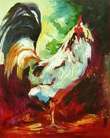Animal paintings are classical oil painting subject. Both realistic and impressional painting technique may apply in the animal painting reproduction or original painting work. The popular animal painting covers the horse, zebra, elephant, cow, woft, etc. Animal art provide excellent pictures for home decorating. Some pet portrait can be painted by our senior artists.
Animal paintings are painted by animal painter who specializes in or is known for their skill in the portrayal of animals, essentially up to about 1900. During the last century "wildlife artist" became the preferred term for contemporary animal painters.
Especially in the 17th century, animal painters would often collaborate with other artists, who would either paint the main subject in a history or mythological piece, or the landscape background in a decorative one. Frans Snyders, a founder of the Baroque animal painting tradition, often provided the animals, and also still-lifes of food, for Peter Paul Rubens; a different landscape specialist might provide the background. In the Dutch Golden Age such specialists tended to produce smaller genre paintings concentrating on their specialism. Animal painters came low down in the hierarchy of genres, but the best painters could make a very good living; many royal and aristocratic patrons were more interested in their subject matter than that of the more prestigious genres. Mainly in England, there were still more specialized painters from the 18th century who produced portraits of racehorses and prize specimens of livestock, whereas in France animal subjects continued to be decorative capriccios often set around garden statuary.
Animalier as a collective plural noun, or animalier bronzes is also a term in antiques for small-scale sculptures in particular, but also paintings, of animals, of which large numbers were produced, often mass-produced, in 19th century France and elsewhere. Although many earlier examples can be found, animalier sculpture became more popular, and reputable, in early 19th century Paris with the works of Antoine-Louis Barye (1795т1875), for whom the term was coined, desisively, by critics in 1831. By the mid-century, a taste for animal subjects was very widespread among all sections of the middle-classes.
Tags:oil painting mediums, still life oil painting, abstract art painting, oil painting on canvas,

 FranУЇais
FranУЇais Deutsch
Deutsch EspaУБol
EspaУБol Italiano
Italiano PortuguУЊs
PortuguУЊs ?Ѕц?Ќу
?Ѕц?Ќу ??ъЕь?
??ъЕь? иЇ?иЙиБиЈ?иЉ
иЇ?иЙиБиЈ?иЉ аБ?аЛаГаА?баКаИ
аБ?аЛаГаА?баКаИ hrvatski
hrvatski Dansk
Dansk Nederlands
Nederlands suomi
suomi ?ЮЛЮЛЮЗЮНЮЙЮКЮЌ
?ЮЛЮЛЮЗЮНЮЙЮКЮЌ рЄЙрЄПрЄЈрЅрЄІр?
рЄЙрЄПрЄЈрЅрЄІр? norsk
norsk Polski
Polski RomУЂn?
RomУЂn? ??ббаКаИаЙ
??ббаКаИаЙ Svenska
Svenska























